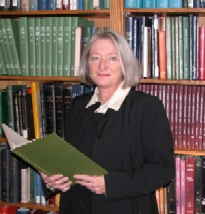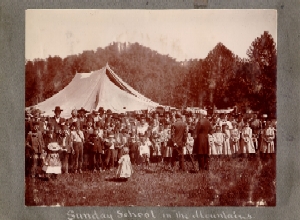Filson Fellowships: Linda Goin
Master’s Thesis Fellow Linda Goin’s study on the Huguenot families of Virginia led her to The Filson Historical Society’s collections earlier this year. Goin, a graduate student at DePaul University, is currently researching the Virginia Huguenot’s influence on the development of the Southern Bible Belt.
By Jennifer Reiss Hannah
Marketing and Public Relations Coordinator
About |
The group of French Protestant refugees who
settled in 1700 in Manakintown, King William Parish,
Virginia, by William Byrd II and England’s King George,
traveled through Europe for 15 years before they agreed to
come to America. Once arriving in Virginia, the families who
stayed on the land set aside by Byrd were anxious to become
citizens  and
to conform to Virginia’s state religion, the Anglican
Church. The group developed the vestry of King William
Parish, a church settlement created specifically for the
Huguenots. One member, Abraham Soblet, instigated a split
among the vestry based on his perceptions of the appropriate
behavior for a minister and how church members conducted
their activities. According to Goin, the schism most likely
occurred due to social mobility. Some members who believed
in a more Congregationalist style of religion, which
included the freedom to gamble, drink and dance, moved to
the north shore of the James River, while the remaining
portion of the group chose to live a more Calvinistic
religious lifestyle on the southern shore of the
river.
and
to conform to Virginia’s state religion, the Anglican
Church. The group developed the vestry of King William
Parish, a church settlement created specifically for the
Huguenots. One member, Abraham Soblet, instigated a split
among the vestry based on his perceptions of the appropriate
behavior for a minister and how church members conducted
their activities. According to Goin, the schism most likely
occurred due to social mobility. Some members who believed
in a more Congregationalist style of religion, which
included the freedom to gamble, drink and dance, moved to
the north shore of the James River, while the remaining
portion of the group chose to live a more Calvinistic
religious lifestyle on the southern shore of the
river.
When Baptists arrived in Virginia prior to the Revolutionary War, the south shore families accepted these ministers, and a vast number of Huguenot ministers and families converted to Baptism. Following the Revolutionary War, many of these ministers traveled westward to Kentucky, which these Frenchmen discovered during their service in the French and Indian War or during the American Revolution.
 Goin’s
goal is to ultimately determine the Virginia Huguenot’s
influence on the development of the Southern Bible Belt
during the late18th and early 19th centuries. Invaluable to
her research are manuscript collections that contain
letters, receipts, and other papers that connect the vestry
families between Virginia and Kentucky and to the Baptist
religion.
Goin’s
goal is to ultimately determine the Virginia Huguenot’s
influence on the development of the Southern Bible Belt
during the late18th and early 19th centuries. Invaluable to
her research are manuscript collections that contain
letters, receipts, and other papers that connect the vestry
families between Virginia and Kentucky and to the Baptist
religion.
Goin mined through various items in The Filson’s Manuscript and Photograph Collections, which provided “valuable insight and factual evidence” to her work. The Trabue Family Papers, 1795-1891, proved a solid connection to descendants of the Virginia Huguenots, even dating the Virginia migrations to Kentucky. The Alice Elizabeth Trabue Papers,1746-1961, contained letters that provided further evidence of relationships between Kentucky and Virginia. Other materials that Goin consulted include the 1795 diary of David Barrow, a Baptist minister who left Richmond, Va., on May 5, 1795, and traveled into Kentucky on a mission. Several volumes of Kentucky Baptist church records included membership lists in which descendants of the Virginia Huguenot families appear. The Green-Guerrant Family Photo Collection contained photographs concerning the Guerrant mission into Kentucky highlands as evangelistic ministers, a possible connection to the Huguenot Guerrant line.
The Filson Historical Society
1310 South Third Street - Louisville, KY 40208
Phone: (502) 635-5083 Fax: (502) 635-5086
Hours
The Ferguson Mansion and Office
Monday - Friday: 9 am. - 5 pm.
Saturday and Sunday closed
Library
Monday - Friday: 9 am. - 5 pm.
Saturday: 9 am. - 12 noon
